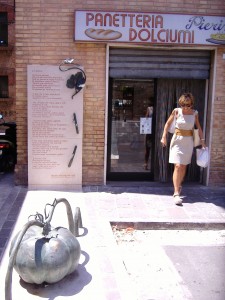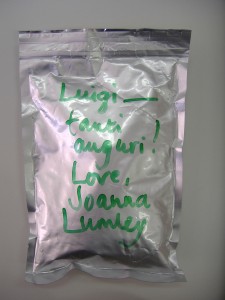Over at the Freakonomics Blog, there’s a Q&A with an eminent agricultural economist, Daniel Sumner of Davis. A timely idea, and some of the questions are actually pretty good, with a few even concerning agrobiodiversity, albeit obliquely. Problem is, I can’t see the answers. What am I missing? We’ve been thinking about doing something similar here, actually. Except not with an agricultural economist. Nor, in fact, with anyone eminent. Just Jeremy and I, at your disposal for a day, to answer questions on agricultural biodiversity, live. What do people think? Worth a try?
Soils and gardens
There’s an exhibition on soil at the Smithsonian in Washington, DC, entitled “Dig it.” And there’s a kids’ book, “Soil! Get the inside scoop,” courtesy of the Soil Science Society of America. I guess the two things are connected. Anyway, they’re both good ideas, and seem to pay due attention to the agrobiodiversity angle.
Speaking of exhibitions, there’s another interesting one relevant to our theme, this one in London. The organizers of IslamExpo have created a traditional Islamic garden at the centre of that busy showcase.
We hope visitors will take a little time out from the main exhibition to wander into one of the four gardens and perhaps sit a while surrounded by the lush planting, under one of the trees of Paradise (pomegranate, fig, date-palm or olive), collecting thoughts or listening to Qur’an recitation or a story by the winner of the Muslim Writers Award, Aliya Vaughan.
Extending extension
I have a thing about extension. I believe it is the great missing link in most thinking — and doing, for that matter — about conservation and use of agrobiodiversity. Genebanks around the world usually have reasonably well-established links with national agricultural research systems, but hardly any contact with extension workers, except maybe when it comes to germplasm collecting. Thats a pity, because extension systems would be valuable at all stages of the conservation-use continuum, from monitoring genetic erosion to targeting collecting to identifying breeding objectives to facilitating the evaluation and adoption of improved varieties.
The problem is that is public agricultural research is under-resourced and dysfunctional in many countries around the world, extension has, if anything, fared even worse. But that doesn’t mean that people dont have any good ideas about how to fix it.
A new KIT publication I saw announced today, for example, looks at the generally positive African experience with outsourcing agricultural advisory services to the private sector. And an IFPRI study reviews the recent reform of the Indian extension service, and also finds good things to say about the increased role of the private sector on the supply side, together with a more participatory approach to planning and implementation on the demand side.
It remains to be seen whether such macro-level changes will result in better linkages among researchers, extensionists and genebanks on the ground. I suspect it will take a major initiative to educate all three sectors in the need to work better together.
La Zucca
That early stirring of globalization that was the Columbian Exchange changed Italian food and cooking forever. That’s well known. What would pizza be like without pomodori and peperoncini, after all? There’s also polenta — and pasta e fagioli. And no doubt also traditional potato-based dishes, though I can’t think of one just now. But the third member of the Mesoamerican Trinity is often forgotten when the usual suspects of the exchange are trotted out, as I’ve just done.
Which is a pity, because the pumpkin features in some pretty nice dishes. 1 So it was nice to see it celebrated last week in Tolentino. We found this sculpture in the piazza which houses the regular fruit and veg market.
On the wall is the text of an ode to the vegetable (or fruit, but I’m not going there) by the local poet Giovanni Sebastiani (1874-1959). You can read “La Zucca” here. But don’t ask me to translate. The local Marche dialect is all but impenetrable to me.
The most valuable bag of seeds no longer in the Svalbard Vault
Thanks, Joanna. And Ola.

